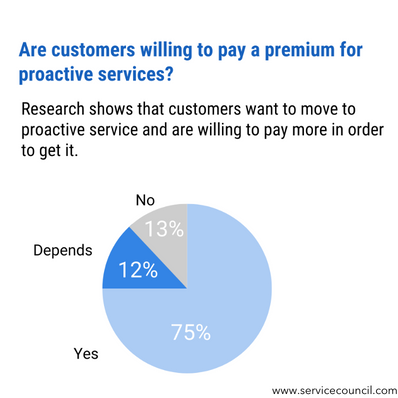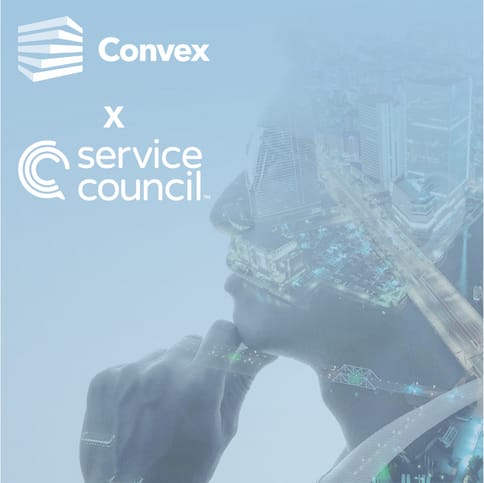We’ve partnered with the Service Council to help commercial services organizations on their pathway to intelligent commercial service sales. In part one, we discussed the case for selling services and in this second part we’ll make the case for innovation in service organizations and impediments that hold organizations back.
The Power of Innovative Service Models for Organizational Growth
Service organizations play a vital role in meeting the evolving needs of building and asset owners. However, not all service organizations are created equal in terms of their service maturity levels. While all have achieved basic break and fix services and 94% have achieved preventative services, a significant gap exists when it comes to adopting proactive, predictive, and outcome-based service offerings. In this blog post, we will explore what these innovative service models entail and why investing in them can bring numerous benefits to service organizations.
Proactive Services: 69% of service companies have achieved this level of offering.Proactive services represent a shift from reactive to proactive maintenance strategies. They involve establishing performance-based contracts and planned and scheduled maintenance activity to achieve customer goals such as energy savings or equipment uptime. Often proactive services are coupled with maintaining onsite inventory and assigned subject matter experts. Through planned maintenance visits, experts are able to identify issues to help avoid sudden asset failure and ultimately increase asset life, performance, and health. Studies by the US Department of Energy show that this type of preventative activity can result in energy savings of up to 18% versus reactive service models.
Predictive Services: 56% of service companies have achieved this level of solutioning.
Predictive services rely on data-driven insights and advanced technologies to anticipate maintenance needs. Traditionally service organizations would predict service levels and sell time and materials contracts or service part sales agreements. With the advancement of Internet of Things (IoT) technologies, companies are able to monitor assets in real time and identify performance anomalies. By analyzing real-time data and historical patterns, service providers can schedule visits much more efficiently, optimize equipment performance, and minimize downtime. According to the Department of Energy, predictive service models can generate 12% cost savings over proactive service models.
Outcome-Based Services: 44% of service companies have achieved this level of maturity.
Outcome-based services focus on delivering specific results to customers, and customers pay for the outcomes achieved. This dynamic represents a win-win where customers achieve their goals and service providers can develop plans that achieve those goals. Traditionally, outcome-based services involved certifications such as LEED or WELL Building Standard rating systems, which evaluate building performance and other efficiency metrics. With the introduction of IoT and new software solutions, asset owners receive reporting and dashboard capabilities that are managed by service providers and built on outcome-based agreements. For example, NRG Part and Johnson Controls recently announced an outcome-based, sustainability initiative that is expected to save $54 million. This partnership includes equipment upgrades, the integration of Johnson Controls’ OpenBlue solution, and ongoing services to measure and verify results.
These advanced service offerings create value for customers and service providers, and there are four primary reasons why service organizations should invest in these innovative service models.
1. Customer Demand and Premium Pricing
The demand for these innovative services is growing, with 75% of customers expressing a desire to adopt proactive service models. Research conducted by the Service Council revealed that up to 87% of customers are willing to pay more for proactive services. Given the expected cost savings from innovative service models, a higher upfront cost is still perceived as a win-win between customers and service providers. Organizations should tap into this market demand and command a premium price for their offerings.

2. Competitive Differentiation
By embracing proactive, predictive, and outcome-based services, organizations can set themselves apart from competitors who are still stuck in reactive service models. Differentiation through advanced services can enhance customer loyalty and attract new clients seeking more comprehensive and value-added solutions.
3. Enhanced Operational Efficiency
Reactive service models are often costly and less profitable due to unexpected breakdowns and unplanned maintenance activities. A series of breakdowns can put strain on field service resources and customer operations. Advanced service models, on the other hand, enable organizations to plan their resources more effectively and optimize their business operations. Predictable maintenance schedules and detecting problems early reduce the likelihood of emergency repairs, resulting in improved operational efficiency and cost savings for the service organization and the customer.
4. Empowered Workforce
Innovative service models provide service teams with more insights about the customer, and frontline workers can use these insights to deliver better customer experiences. With access to real-time data and insights, service providers can arrive at customer sites prepared, which leads to (1) more efficient service visits and (2) recommending alternative solution areas. An empowered workforce can enhance customer satisfaction, show higher job satisfaction, and generate higher productivity and profitability for an organization.
However, service attach rates vary substantially by organization. According to Service Council research, top performing organizations attach services to 76% of product sales. Average performing organizations only attach services to 39% of product sales. There are five key challenges that hold back organizations from selling innovative service solutions.
1. Ineffective Sales of Services: Often, service offerings are not effectively sold alongside equipment or products, leading to untapped revenue opportunities. Sales teams should be trained and incentivized to promote and sell service packages as integral components of the overall value proposition.
2. Disparate Data and Limited Customer Visibility: Fragmented customer data across multiple systems hinders the ability of sales teams to gain insights into existing customers. A lot of equipment records are difficult to find and contextualize. By consolidating customer data, investing in customer relationship management (CRM) systems, or other sales intelligence solutions, organizations can collect a holistic view of customers, enabling personalized and targeted service offerings.
3. Lack of Market Intelligence: Access to timely and relevant market intelligence is crucial for service organizations to make informed decisions and stay ahead of the competition. Investing in solutions that provide intelligence on properties, permits, contacts, and companies helps organizations get a competitive edge.
4. Administrative Tasks: The significant amount of time spent on administrative tasks detracts from valuable resources that could be allocated to revenue-generating activities. Streamlining administrative processes and providing sales representatives with tools to automate tasks, limit manual data entry, and increase their focus can optimize their productivity.
5. Research Time: Employees spending excessive time on researching information detracts from their customer engagement and sales efforts. Providing comprehensive knowledge management systems and resources can reduce research time and enable sales representatives to focus on building relationships and closing deals.
In an increasingly competitive landscape, service organizations must embrace advanced service models to unlock revenue growth and satisfy customer expectations. Proactive, predictive, and outcome-based services not only cater to customer demand but also bring numerous benefits to service providers, including enhanced differentiation, operational efficiency, and employee satisfaction. At Convex, we build software solutions for commercial services businesses that provide revenue generating teams a comprehensive customer view on prospective and existing customers. In our next post, we will dive into key strategic actions that service organizations can take to enable successful service revenue sales. Stay tuned for valuable insights and practical tips!
Interested in learning more?
Sign up to download the Service Council research insight
Read the next part in the blog series: Strategic Actions to Enable Service Revenue Sales
Learn about how Convex can help grow your service business
Share





